U.S. Review
Politics Takes Center Stage
- The release of the transcript of President Trump’s phone conversation with Ukraine President Volodymyr Zelenskiy and the whistleblower complaint overshadowed most of this week’s economic reports and took bond yields modestly lower.
- Consumer confidence came in weaker than expected in September, falling 9.1 points to 125.1. The jobs plentiful series fell back from its cycle high hit the previous month.
- Durable goods orders rose 0.2% in August, but nondefense capital goods orders fell by a like amount and were revised lower for the prior month, indicating that capital spending continues to lose momentum.
One More Ball to Juggle
The onslaught of news reports concerning President Trump’s midsummer phone call with Ukrainian President Volodymyr Zelenskiy overshadowed most of this week’s economic reports. The impeachment inquiry is almost certain to dominate the headlines, but Trump’s strong support within the Republican Party means he is unlikely to be removed from office. His 91% approval rating among Republicans, according to Gallup, is a key variable to watch—if it slips, market volatility is likely to increase. The impeachment investigation and related hearings might make it even more difficult to reach a meaningful trade deal with China. The market had placed fairly low odds on such a deal being reached, however. Legislation should still move forward on many fronts, including the USMCA, or update of NAFTA (see Topic of the Week).
This week’s economic reports reinforce the notion that U.S. economic growth is continuing to lose momentum. While slower growth overseas is responsible for much of the drag on U.S. growth, consumers and businesses appear to have become more guarded about the outlook. Consumer Confidence fell by a larger than expected 9.1 points to a still respectable 125.1. Consumers grew more cautious about both the present situation and future conditions. The robust assessment of the labor market a month earlier was also completely reversed.
Too much should not be made of the big drop in Consumer confidence. The Conference Board’s survey was out of sync with the University of Michigan’s Consumer Sentiment Survey, which was reported Friday morning. Consumer sentiment rose 1.2 points to a solid 93.2. Measures of consumer confidence tend to track spending and employment conditions over time but do a poor job of predicting month-to-month changes.
Consumer spending for August came in slightly below expectations, rising just 0.1%, while spending growth for the prior month was revised 0.1 percentage point lower to just a 0.3% gain on an inflation-adjusted basis. The smaller rise in consumer spending brings outlays a touch below our expectations but well below the consensus which had been looking for a stronger gain. Consumers appear to be in solid shape, however. Nominal personal income rose 0.4% in August, led by wages & salaries, which rose 0.6%. With income outpacing spending, the saving rate rose back above 8%. Consumers certainly have the wherewithal to keep spending on a solid path.
Advance orders for durable goods rose 0.2% in August, but the key nondefense capital goods ex-aircraft orders fell 0.2% and saw orders for the prior month revised from a 0.2% gain to unchanged. Shipments rose modestly. The orders numbers are clouded by the slowdown in Boeing’s 737 Max production as well as the GM strike, which is beginning to have some impact on parts inventories. We incorporated the weakness in capital spending in our latest forecast and both the softer consumer spending and core durable goods shipments data remain consistent with our estimate of 1.6% third quarter real GDP growth.
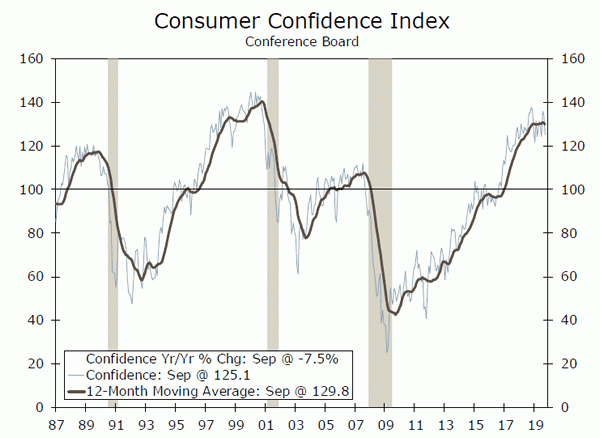
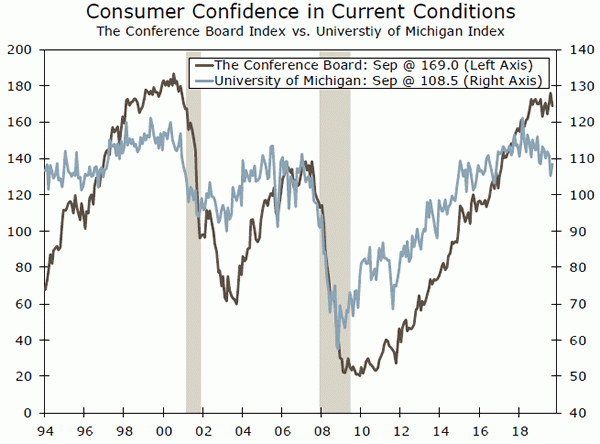
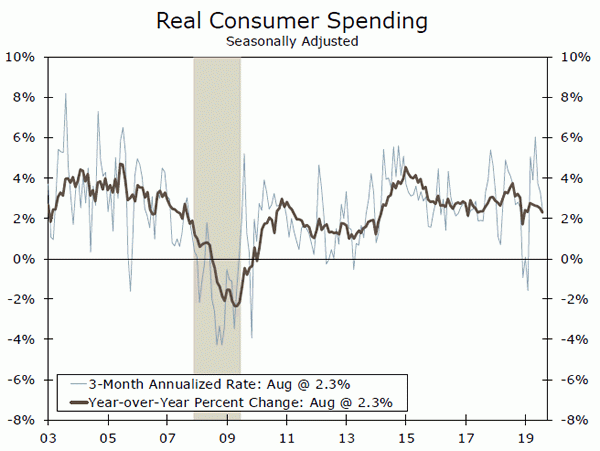
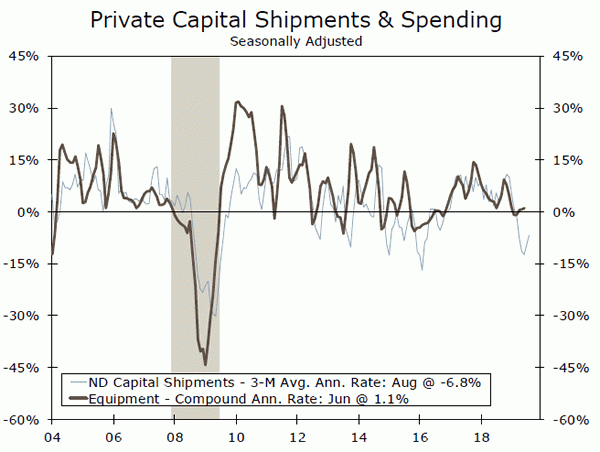
U.S. Outlook
ISM Manufacturing • Tuesday
U.S. manufacturers have experienced a great deal of stress as the ongoing trade war, slowing global growth and overall economic uncertainty have taken an increasing toll. Indeed, the headline ISM manufacturing index recently fell into contraction territory for the first time since 2016. Details in the August report, as well as underlying fundamentals, suggest the headline index will remain under pressure for at least a few more months. The forward-looking new orders component fell to 47.2, which ties the cycle low set in 2012, while the backlogs component remained in contraction territory for the fourth straight month.
No doubt, increased economic anxiety related to escalated trade tensions and tariffs is weighing heavily on business confidence. With a clear trajectory of further escalation in this trade war (right chart), manufacturing activity is poised to remain depressed in the near term.
Previous: 49.1 Wells Fargo: 49.9 Consensus: 50.3
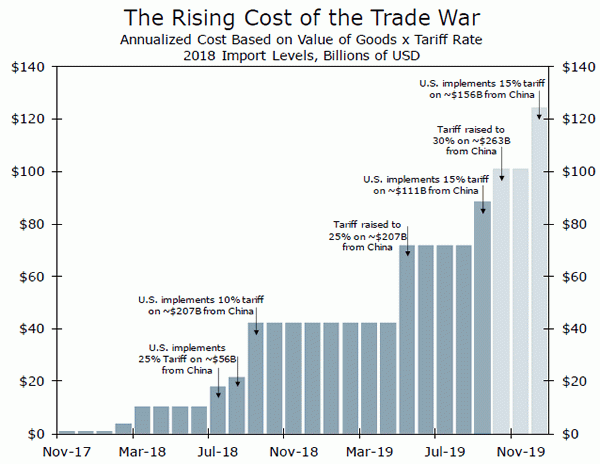
ISM Non-Manufacturing • Thursday
While the manufacturing blues continue, the non-manufacturing sector remains resilient. The headline ISM non-manufacturers index rebounded in August, posting a three-month high, with gains recorded in the business activity and new orders components.
However, we remain cautious that the bifurcation between the nonmanufacturing and manufacturing sectors will continue. This concern, in part, arises from the declines we have seen in the employment indices, which are key indicators of how businesses view the outlook. In August, the non-manufacturing employment component fell to its lowest level in more than two years, while the manufacturing measure dropped to its lowest level since March 2016. If the pace of nonfarm hiring continues to slow as we anticipate, we should begin to see further deceleration in the pace of growth in the non-manufacturing sectors.
Previous: 56.4 Wells Fargo: 54.1 Consensus: 55.0
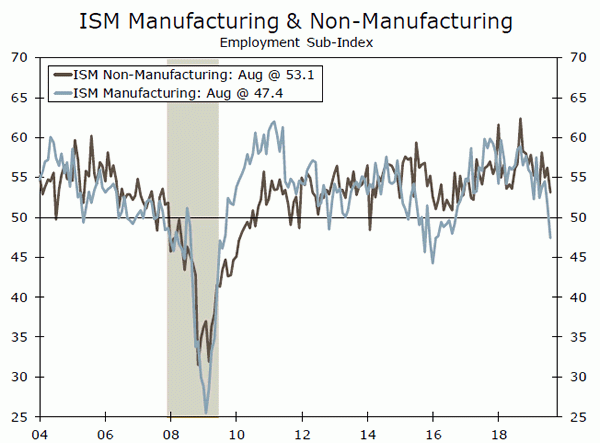
Employment Report • Friday
The pace of hiring continues to cool. In August, nonfarm payrolls increased a weaker than expected 130,000, with prior months’ hiring downwardly revised. That soft August print was even boosted by the hiring of 25,000 temporary workers for the 2020 Census. By sector, job gains continue to soften across the board, suggesting weakness beyond the trade-related sectors. The combination of reduced breadth and strength of hiring suggests that the pace of economic momentum is weakening in the second half of the year.
Looking to September’s performance, we project nonfarm payrolls to remain cool, adding 130,000 jobs. As highlighted above, the ISM employment components continue to trend lower, reflecting firms’ cautious approach to hiring in the face of increased economic anxiety. We look for the unemployment rate to remain steady at 3.7% and for a 0.3% monthly gain in average hourly earnings.
Previous: 130,000 Wells Fargo: 130,000 Consensus: 140,000
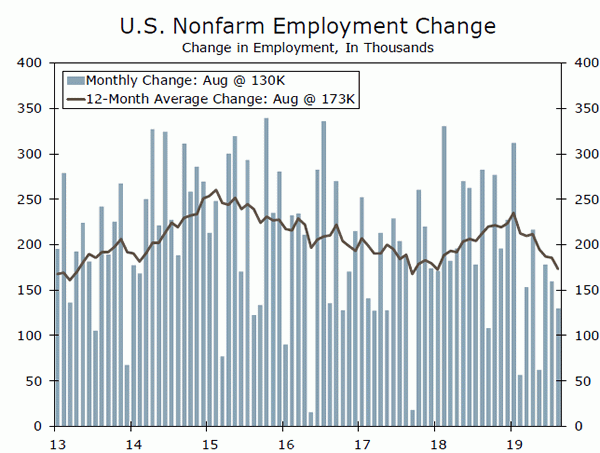
Global Review
Eurozone Economy Continues to Falter
- Preliminary data on economic activity in the Eurozone in September were disappointingly weak, signaling the slowdown there will not subside by the end of the third quarter.
- Data on the country-specific level were not much better. The PMI for manufacturing in Germany declined to 41.4 in September, down from 43.5 in August and a cycle high of 63.3 in December 2017.
- Mexico’s central bank continued to ease monetary policy this week, cutting its main policy rate 25 bps, the second such move this year.
Eurozone Economy Continues to Falter
Preliminary data on economic activity in the Eurozone in September were disappointingly weak, signaling that the slowdown there will not subside by the end of the third quarter. The manufacturing PMI for the Eurozone fell to 45.6 in September and the services PMI declined to 52.0. Taken together, the composite index is now just 50.4, barely above the key 50 demarcation line between expansion and contraction. At 45.6, the Eurozone manufacturing PMI is testing the lows reached during the depths of the European sovereign debt crisis in 2012.
Data at the country-specific level were not much better. The German manufacturing PMI, for example, declined to 41.4 in September, down from 43.5 in August and a cycle high of 63.3 in December 2017. At present, we only have hard data on factory orders and industrial production in Germany through July, but that data suggest the factory sector is contracting at least as fast as it did during the sovereign debt crisis, if not worse.
For most of 2019, the European Central Bank had stood pat, neither easing nor tightening monetary policy. This made some sense to us, as there continued to be enough strength in the service sector to offset weakness in the manufacturing sector. The PMI data released this week are just one data point, but they are a discouraging sign that the factory sector weakness might be starting to win this tug of war. The most recent move by the ECB to cut rates and restart QE may prove to be a prescient one, but it remains an open question whether the additional monetary policy stimulus will be enough to halt the current slide.
Mexico’s central bank continued to ease monetary policy this week, cutting its main policy rate 25 bps, the second such move this year. Inflation has been falling in Mexico for some time (middle chart), but the central bank only began to cut rates in the past few months. As a result, real interest rates have been relatively high, which has likely supported the currency but has been a drag on economic growth. Real GDP growth in Mexico was -0.8% on a year-over-year basis in the second quarter, the weakest pace since 2009.
The Mexican economy has faced multiple headwinds of late. Trade uncertainty has been a challenge, though the central bank noted in its statement that the risk of the United States imposing tariffs on Mexican imports had “dissipated somewhat.” The ongoing issues in the Mexican oil sector are another hurdle. Pemex, the stateowned petroleum company, has seen its credit outlook deteriorate amid high debt levels and oil output in Mexico that has cratered over the past few years, a sharp divergence with the United States over the same period (bottom chart). Since Pemex is state-owned, this deterioration in its credit outlook has weighed on Mexico’s sovereign credit standing and has likely contributed to higher sovereign bond yields than would otherwise be the case. At present, markets are priced for 188 bps of additional easing over the next year by the Bank of Mexico. For comparison, markets are priced for 55 bps of additional central bank easing in the United States over the same period, and 18 bps of easing in Canada.
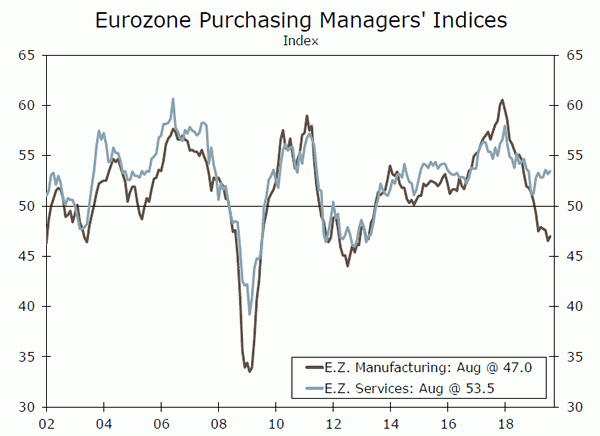
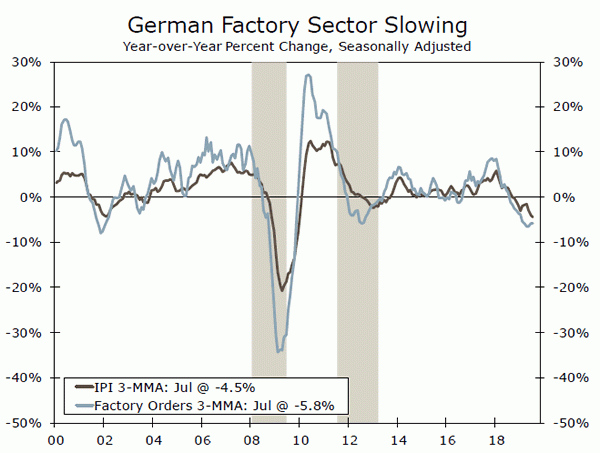
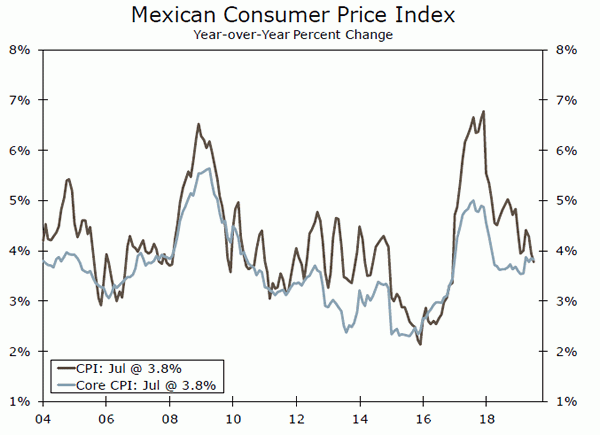
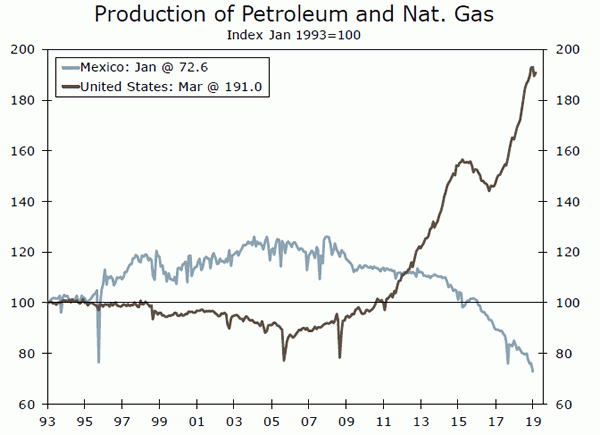
Global Outlook
Japan Industrial Production • Monday
Industrial production growth in Japan has been slowing over the past couple of years, in line with the broader slowdown in global growth. Although the data were a bit stronger in July, the continued escalation in trade tensions between the United States and China over the past of couple months appears to have pushed the global manufacturing cycle even deeper into negative territory, based off of the available preliminary data. Manufacturing accounts for about 16% of total employment in Japan. In comparison, the same number in the United States is about 8%.
Thus far, the Bank of Japan has resisted easing monetary policy any further, unlike other major developed economy central banks like the Federal Reserve and European Central Bank. There are growing concerns, however, that as the global economy has continued to weaken, the Bank of Japan may be forced to act, particularly if the yen strengthens too much.
Previous: 1.3% Consensus: -0.5% (Month-over-Month)
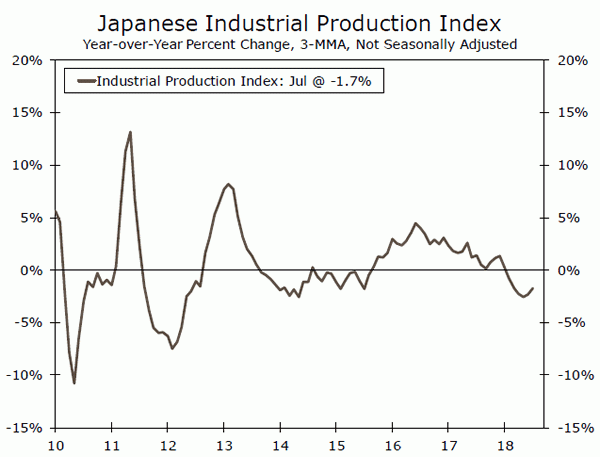
Eurozone CPI • Tuesday
Consumer price inflation in Europe has bounced around a bit of late, but through the noise, price growth remains well shy of the central bank’s target. Since the start of 2016, the range on year-over-year core CPI inflation is 60 bps, with core inflation hovering between 0.7% and 1.3%. Core inflation in the Eurozone has not been above 1.5% since 2012.
At its last meeting, the European Central Bank made clear that rates would “remain at their present or lower levels until it has seen the inflation outlook robustly converge to [target].” The ECB also made its asset purchase program open-ended in timing, pledging to buy assets “as long as necessary.” Thus, unless prices begin to accelerate, it seems the ECB’s newest foray into easier monetary policy is unlikely to end anytime soon. Christine Lagarde, who is to replace Mario Draghi as ECB president later this year, will likely inherit extraordinarily easy monetary policy with no end in sight.
Previous: 1.0% Consensus: 1.0% (Year-over-Year)
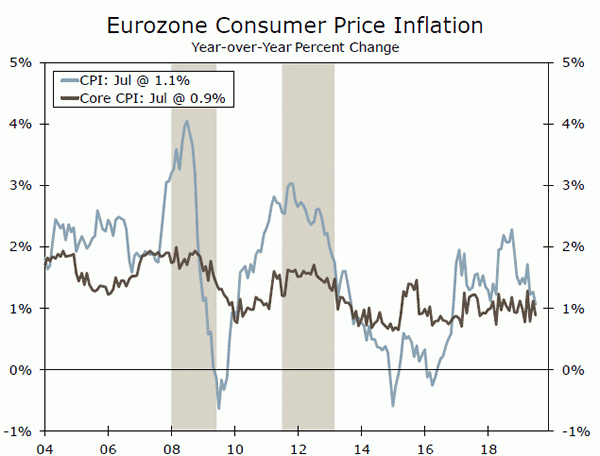
Reserve Bank of India Meeting • Friday
Real GDP growth in India was just 5.0% year-over-year in the second quarter, the weakest pace since Q1-2013. The slowdown thus far has been even worse than the one associated with the 2016-2017 demonetization period in India. The Reserve Bank of India targets inflation of 4% plus or minus two percentage points, and here too the numbers have come in on the low side. Headline inflation in India was just 3.2% in August on a year-over-year basis and has not been above 4% since July 2018.
The RBI has already reduced its main policy rate nearly 100 bps this year in an effort to give the economy a boost. At present, markets are priced for another 65 bps of rate cuts from the RBI over the next year. Prime Minister Modi also recently announced a new round of tax cuts to boost growth, though this raised some concerns about the sustainability of the budget deficit, which was already expected to be 6%-7% of GDP in 2020.
Previous: 5.40% Consensus: 5.15% (Repurchase Rate)
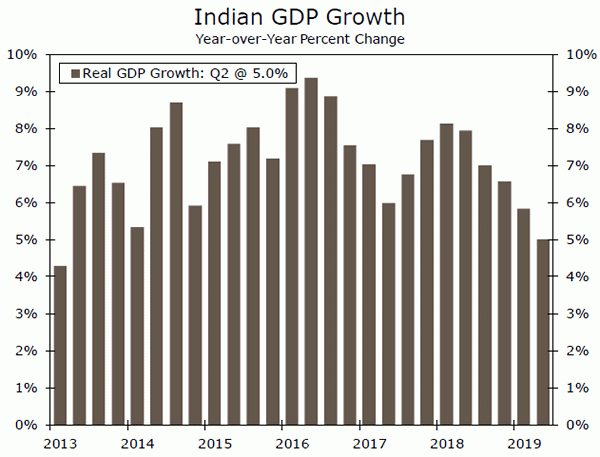
Point of View
Interest Rate Watch
Repo: What Does the Fed Do Now?
As we wrote in this column last Friday, there were some wild gyrations in money markets last week. Not only did the Federal Reserve conduct four repurchase (repo) operations last week to add liquidity to the financial system, but it continued those operations this week. In total, the Fed has conducted $706 billion of repo operations since last week (top chart). Furthermore, the Fed has announced that it will offer at least $75 billion per day in overnight repo operations through October 10 to ensure that money markets remain stable.
In that regard, the Fed’s actions to date seem to have succeeded in bringing stability back to money markets. After spiking higher last week, the Secured Overnight Funding Rate (SOFR), which is the heir apparent to LIBOR, has moved back down to “normal” levels (middle chart). The effective fed funds rate, which last week traded above the Fed’s target range, has receded back into the current target range of 1.75% to 2.00%.
But, the question remains about what the Fed will do to prevent such volatility from returning to money market interest rates in the future. In an in-depth report that we wrote this week, we discussed the various options that the Federal Reserve may have. In the near term, we suspect the Fed will continue to use ad hoc repo operations to ensure that money market rates remain under control.
We also think that the Fed will allow its balance sheet to grow organically again, perhaps starting as soon as the October 30 FOMC meeting. The FOMC could potentially authorize some discrete amount of Treasury security purchases to provide more reserves to the banking system. But we believe that the FOMC may want to avoid this option, because the market could mistakenly infer that the Fed was ramping up its quantitative easing program again.
Eventually though, the Fed will need a longer-term solution, and we believe that it will adopt a standing repo facility (SRF) that banks and primary dealers could tap “automatically” to secure liquidity on a collateralized basis. If the Fed is successful, then sharp spikes in short-term interest rates should become very rare.
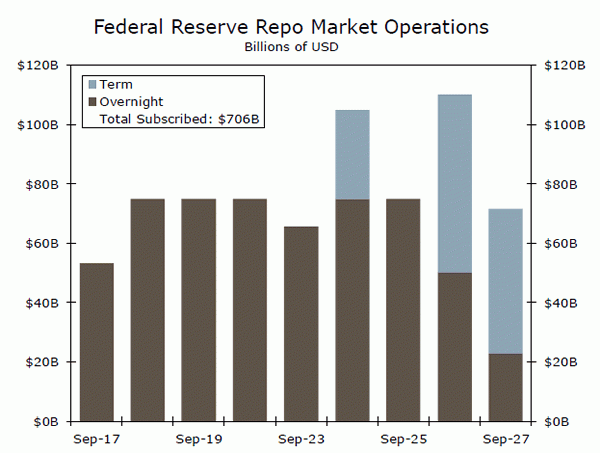
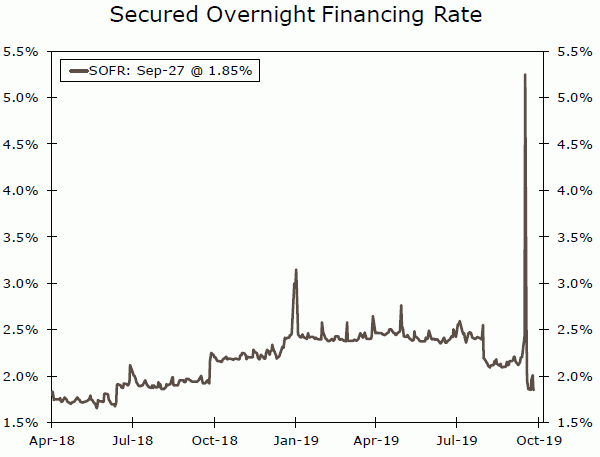
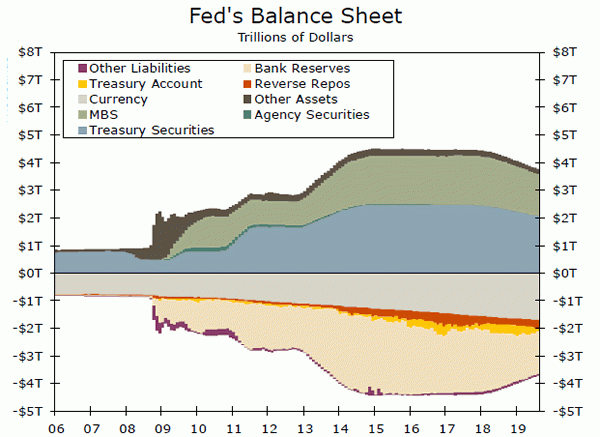
Credit Market Insights
Household Balance Sheets Remain Strong
Household net worth grew $1.85 trillion in the second quarter to $113.5 trillion, according to the Financial Accounts of the United States released last week by the Fed. Of this rise, $900 billion came from increases in the value of directly and indirectly held corporate equities. Financial assets overall continue to make up the majority of household assets. After rebounding a sharp drop in the fourth quarter of last year, financial assets now make up almost 70% of total assets. While this is down from slightly from its peak in 2014, it remains high by historical standards.
On the other side of the balance sheet, household debt increased at a 4.3% annualized rate in the second quarter. This increase, however, was not enough to outweigh the growth in assets or disposable incomes. The household assets-to-liabilities ratio continued its climb and now stands at 8.0, the highest level since 1984. Liabilities as a percent of disposable income also shows a positive trend for households, with the ratio improving this quarter to its lowest level since 2001. While these aggregate numbers paint a promising picture, data released by the Census Bureau on Thursday suggest a bleaker reality. Income inequality, as measured in the American Community Survey, reached its highest point on record. While it is important to pay attention to distributional differences that may hide below aggregate numbers, economic data as a whole continue to suggest the American consumer is poised to continue spending.
Topic of the Week
Impeachment Drama Stirs the Pot in D.C.
Impeachment drama stole the show this week, as headlines swirled that the House of Representatives might move to impeach the president. In a practical sense, House Speaker Nancy Pelosi’s announcement that the House “is moving forward with an official impeachment inquiry” simply means that the House of Representatives will investigate President Trump on impeachable offenses, something a few committees were arguably already doing. At this point in time, there is no scheduled vote on impeachment in the House, and any such vote seems unlikely in the immediate future.
If the House did vote to impeach the president, it would take a simple majority vote to pass. From there, the Senate would hold a trial, and it would require two-thirds of the Senate to vote to remove the president from office.
In any event, the relationship between House Democrats and President Trump seems unlikely to improve against this backdrop. This threatens two key legislative developments in the coming months. First, Congress still needs to pass a budget for FY 2020, which begins on October 1. To buy more time for negotiations, Congress recently passed a continuing resolution to fund the government through November 21. Continued disagreements over funding for a wall on the U.S.-Mexico border have been a major hurdle to a full-year budget agreement. Any move toward impeachment is unlikely to help push negotiations in a positive direction.
The other major legislative item on the agenda in the coming months is the USMCA, the proposed replacement for NAFTA. At present, the executive branch has not yet formally submitted a bill to Congress, which once done would start a 90-legislative day clock on a vote. Prospects for USMCA passage had been improving, with Speaker Pelosi saying just last week that “we hope that we’re on a path to yes.” Our forecast continues to assume that the USMCA will eventually be passed, but the timeline and political backdrop is starting to look precarious. If the budget and impeachment consume much of the oxygen over the next few months, it will be difficult to pass the USMCA by year-end/early 2020. And in our view, the closer it gets to the 2020 election, the less members of Congress will want to vote on a major trade deal.
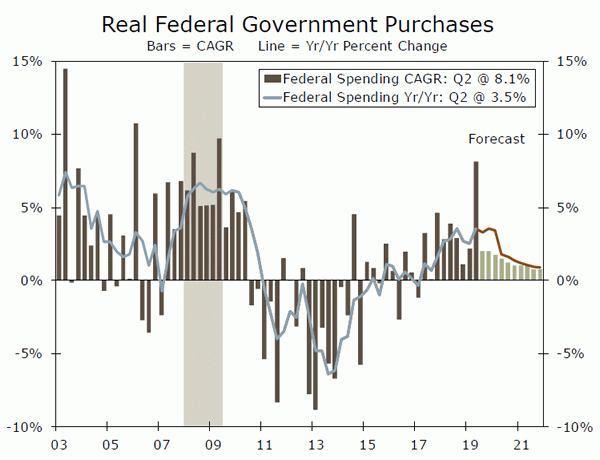
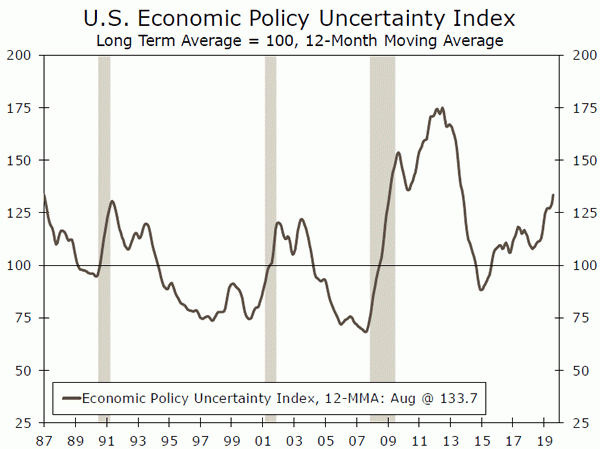

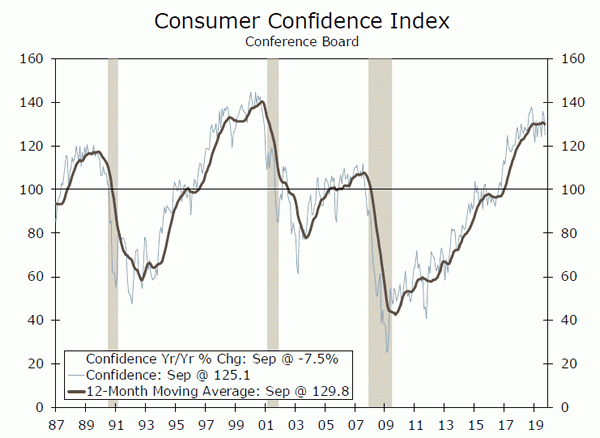
 Signal2forex.com - Best Forex robots and signals
Signal2forex.com - Best Forex robots and signals




